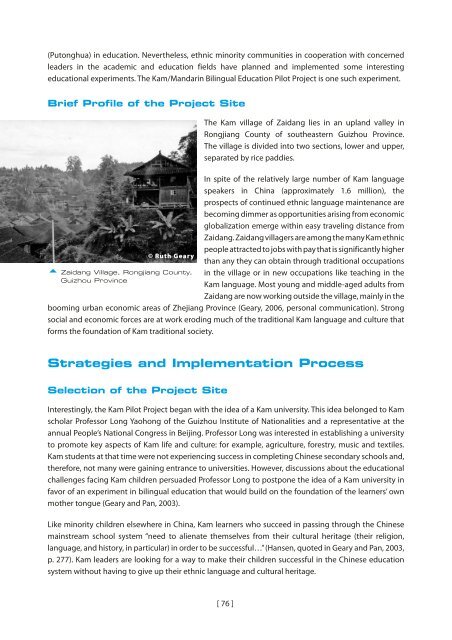Mother Tongue-based Literacy Programmes: Case Studies of Good ...
Mother Tongue-based Literacy Programmes: Case Studies of Good ...
Mother Tongue-based Literacy Programmes: Case Studies of Good ...
Create successful ePaper yourself
Turn your PDF publications into a flip-book with our unique Google optimized e-Paper software.
(Putonghua) in education. Nevertheless, ethnic minority communities in cooperation with concernedleaders in the academic and education fields have planned and implemented some interestingeducational experiments. The Kam/Mandarin Bilingual Education Pilot Project is one such experiment.Brief Pr<strong>of</strong>ile <strong>of</strong> the Project Site© Ruth Geary Zaidang Village, Rongjiang County,Guizhou ProvinceThe Kam village <strong>of</strong> Zaidang lies in an upland valley inRongjiang County <strong>of</strong> southeastern Guizhou Province.The village is divided into two sections, lower and upper,separated by rice paddies.In spite <strong>of</strong> the relatively large number <strong>of</strong> Kam languagespeakers in China (approximately 1.6 million), theprospects <strong>of</strong> continued ethnic language maintenance arebecoming dimmer as opportunities arising from economicglobalization emerge within easy traveling distance fromZaidang. Zaidang villagers are among the many Kam ethnicpeople attracted to jobs with pay that is significantly higherthan any they can obtain through traditional occupationsin the village or in new occupations like teaching in theKam language. Most young and middle-aged adults fromZaidang are now working outside the village, mainly in thebooming urban economic areas <strong>of</strong> Zhejiang Province (Geary, 2006, personal communication). Strongsocial and economic forces are at work eroding much <strong>of</strong> the traditional Kam language and culture thatforms the foundation <strong>of</strong> Kam traditional society.Strategies and Implementation ProcessSelection <strong>of</strong> the Project SiteInterestingly, the Kam Pilot Project began with the idea <strong>of</strong> a Kam university. This idea belonged to Kamscholar Pr<strong>of</strong>essor Long Yaohong <strong>of</strong> the Guizhou Institute <strong>of</strong> Nationalities and a representative at theannual People’s National Congress in Beijing. Pr<strong>of</strong>essor Long was interested in establishing a universityto promote key aspects <strong>of</strong> Kam life and culture: for example, agriculture, forestry, music and textiles.Kam students at that time were not experiencing success in completing Chinese secondary schools and,therefore, not many were gaining entrance to universities. However, discussions about the educationalchallenges facing Kam children persuaded Pr<strong>of</strong>essor Long to postpone the idea <strong>of</strong> a Kam university infavor <strong>of</strong> an experiment in bilingual education that would build on the foundation <strong>of</strong> the learners’ ownmother tongue (Geary and Pan, 2003).Like minority children elsewhere in China, Kam learners who succeed in passing through the Chinesemainstream school system “need to alienate themselves from their cultural heritage (their religion,language, and history, in particular) in order to be successful…” (Hansen, quoted in Geary and Pan, 2003,p. 277). Kam leaders are looking for a way to make their children successful in the Chinese educationsystem without having to give up their ethnic language and cultural heritage.[ 76 ]

















